#hedammu
Text
"Zeus himself, the central character in Hesiod’s Theogony, bears some of the most easily recognizable Northwest Semitic features, in addition to those of the Indo-European Sky God inherited by the Greeks. It is not necessary, therefore, to discuss them at length. It suffices to recall that the Canaanite Storm God Baal and the homologous Greek god share a similar position in the succession of kings in Heaven, as well as the position of the youngest son. They both reign from a palace on a northern mountain (Olympos, Zapanu/Zaphon), and they wield thunder as their distinctive weapon. As with his Near Eastern counterparts, thunder, lightning, and the thunderbolt were the “missiles/shafts of great Zeus.” The position of his sister and principal consort Hera is like that of Anat, Baal’s sister and partner (though not consort). For some, this coupling “violates the incest taboo” in Greek myth but allows Hera to remain an “equal” partner according to her right of birth, as the daughter of Kronos. In Il. 4.59 she is the oldest daughter, in Il. 16.432,18.352 she is called “sister and wife” and in Hesiod Th. 454 she is the youngest daughter of Kronos, exactly as Zeus is the last son.
The list of similarities between Zeus and the different manifestations of the Canaanite god (either Baal or El or Yahweh in the later Hebrew theology) is long and has been the subject of much discussion by classicists, Semitists, and biblical scholars. Perhaps most interesting are the parallels noticeable at the level of their epithets, such as Zeus the “cloud-gatherer” (nephelegereta)or “lightener” (asteropetes), and the frequent characterization of Baal in Ugaritic poetry as the “cloud-rider” (rkb ʿrpt). Other epithets of the Northwest Semitic Storm God Adad (Haddad) are preserved in Akkadian hymns, such as “lord of lightning” or “establisher of clouds.” …
Zeus’ “high-in-the-Sky” position and Sky-nature are reflected in other epithets such as hypatos and hypsistos. At the same time, similar divine epithets meaning “the high one” (eli, elyon, and ram) are very common in Northwest Semitic religious texts, accompanying several principal divinities. For instance, this epithet is used in the Ugaritic epic for Baal, and different forms of the adjective are attested in Aramaic, as well as in the Hebrew Bible accompanying El, Yahweh, and Elohim. … The association of the Storm God in Syro-Palestine with the bull as a symbol of fertility is also present in the various mythological narratives involving Zeus, most clearly in the famous motif of Zeus’ kidnapping the Phoenician princess Europa and carrying her on his back after taking the shape of a bull.
The final fight of Zeus with Typhon (Th. 820-880) has also been compared to the fight between Baal and Yam (the Sea) in the Ugaritic Baal Cycle and to that between Demarous and Pontos (the Sea) in Philon’s Phoenician History (P.E. 1.10.28). As mentioned earlier, the Storm God’s struggle with a monster also (albeit more distantly) resembles the clash between the Hurrian Weather God Teshub and the monsters Ullikummi, Illuyanka, and Hedammu. The figure of Typhon in Hesiod can in fact be seen as a Greek version of a “cosmic rebel” repeatedly reimagined with different characteristics in the specific versions, who endangers the Weather God’s power and generally has both marine and chthonic features. The Levantine and Greek adversaries probably have more than a merely thematic resonance, as the very name of Typhon might have a Semitic origin. It has hypothetically but quite convincingly been associated with the Semitic name Zaphon. Mount Zaphon (Ugaritic Zapunu or Zapanu) is a central point of reference in the geography and the religion of Ugarit. Known by Greeks and Romans as Kasion oros/ mons Casius (today Jebel al-Aqra), this peak on the north coast of Syria (south of the Orontes River) was also mentioned in Hurrian-Hittite myths. The mountain occupies a central spot in both the fight between Ullikummi and Teshub (as Mount Hazzi) and in the Ugaritic Baal Cycle. In the Ugaritic epic, the fight against Yam (the Sea) is not described as taking place on the mountain, but the celebration of Baal’s victory is, as it is the god’s abode overlooking the Mediterranean: “With sweet voice the hero sings / over Baalu on the summit / of Sapan (= Zaphon).” Much later, Apollodoros locates the cosmic fight with Typhon on Mons Casius precisely, which indicates that the link between Typhon and Zaphon had persisted, even though the name known to Hellenistic authors was the Greek, not the Semitic one."
- When the Gods Were Born: Greek Cosmogonies and the Near East by Carolina López-Ruiz
10 notes
·
View notes
Text
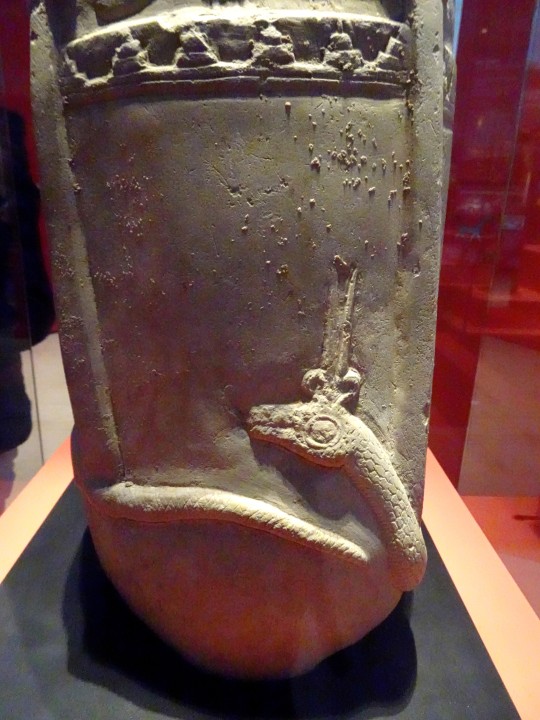



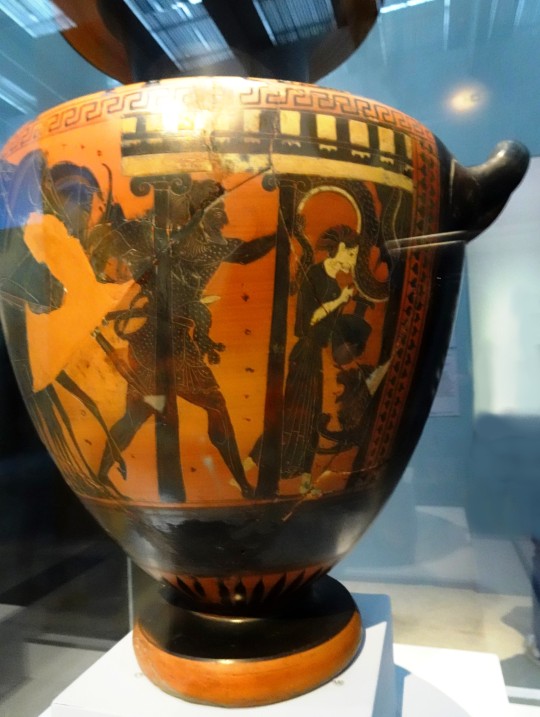


Il y a une petite quinzaine, je suis allé avec Julien et Katie, au Louvre-Lens pour une expo temporaire : “Animaux Fantastiques”. Une très belle expo ! Ici des hydres et des serpents :
stèle "kudurru" - le "bashmu", serpent venimeux de la Mer Primordiale - Irak, 1200 av. J-C.
les 2 suivantes : amphore , Héraklès, avec Athéna et Iolaos, et l'Hydre de Lerne - Athènes, 530 av. J-C.
sceau-cylindre, Ninurta contre les serpents "Bashmu" - OU bien - Marduk contre Tiamat - Irak, 900-600 av. J-C.
orthostate - Teshup, dieu hittite de l'Orage et Tasmishu combattant le serpent marin Hedammu - Aslantepe, Turquie, 1200 av. J-C.
amulettes - Egypte, 660-330 av. J-C.
#expo#louvre-lens#animaux fantastiques#monstre#créature#hydre#serpent#archéologie#mythologie#kudurru#mésopotamie#bashmu#héraklès#héraclès#athéna#iolaos#hydre de lerne#12 travaux d'hercule#ninurta#marduk#tiamat#hittite#orthostate#teshup#tasmishu#hedammu#aslantepe#turquie#égypte antique#amulettes
2 notes
·
View notes
Text
from perkunos to indra & zeus
Anatolian languages:
tarhuan, tarhunna, tarhunnaradu - hittite (linked w bull in anatolia)
tarhu, tarhunz, tarhunta, tarhuwant - luwian
tarhuwanta - palaic
trqqas - lycian
taru - hattian
teshub - hurrian
turvant - sanskrit cognate for indra?
aleppo -
hadad - mesopotamia?
iskur - sumeria?
zeus - greek
indra - vedic
trokondas - rome
jupiter dolichenus - armenian/roman
- associated with sky, weather, lightning, thunder, battlefield, commander, mountains, helpful, slaying enemies with an axe, vanquishing, decided whether would be drought and famine or fertile fields and good harvests, thunderbolt becomes axe
religious treatment
- "Weather god of the thunderbolt, glow on me like the moonlight, shine over me like the son god of heaven!" - KUB 6.45 iii 68-70, Hittite king Muwatalli II’s personal god who he referred to as “my lord, king of heaven” (associated with Anatolia’s bulls instead of horses)
- Hittite king Warpalawas II made rock relief and animals were sacrificed to him
- Luwian magic rituals intended to bring rain or heal the sick
- chief god of the luwians, whose chariot was pulled by horses. later depicted standing on a bull.
- cows + sheep were sacrificed to him for grain + wine to grow
- in curses, he was called upon to “smash enemies with his axe” and gave the king royal power, courage and marched him in battle - in late Luwian texts
- Pegasus, Greek winged horse which carries Zeus’ thunderbolt name comes from one of his epithets piḫaššašši meaning “of the thunderblot”
cult sites
- Aleppo, Syria, major city of the weather god - conquered by Hittite king Suppiluluima I who installed his son Telipinu as priest-king. Temple for weather god was modified to conform to Hittite cult
snake/dragon slayer myth near Mount Kasios in Syria & Corycus in Turkey
- Illuyanka in Hittite
- Hedammu in Hurrian
- Typhon in Greek (taken from Cilicia)
- Naga in Sanskrit
#weather god#zeus#indra#taru#tarhunta#mythology#prehistory#syria#anatolia#india#south asia#levant#archaeology#comparisons#indo european#greek#luwian#anatolian#aleppo#hittite#hurrian#hatti#compare
4 notes
·
View notes
Text
The Pantheon universe, a summary
What is the Pantheon universe?
Pantheon is a series of mythological stories that take place from approximately 3000 BCE to 1200 BCE in the area known in modern times as SWANA (Southwest Asia and North Africa).
The stories assume the existence of each ancient culture’s deities while taking into account the historical conflicts between those cultures, resulting in a kind of “historical mythology” where historical conflict reflects upon the divine realm (E.G.: the Egyptian pantheon fighting the Hittite pantheon and allies in the Battle of Kadesh story).
What tags organize this blog?
Find Pantheon artwork: #iconography
Find Pantheon written work: #textcorpus
Find Pantheon lore (short posts): #lore
Find Papyrus Nabayat content: #papyrusnabayat
Find Baal Cycle content: #baalcycle
Find Battle of Kadesh content: #battleofkadesh
Individual mythology groups have their own tags below, as do some of the gods. Not all gods can be linked below for space reasons, but they are tagged.
Which gods have a prominent place in Pantheon?
Syrian and Amorite Deities - #amorite mythology
Baal, Ugaritic god of storms #baal
Yam, Ugaritic god of the sea #yam
Mot, Ugaritic god of death #mot
Anat, Ugaritic goddess of war #anat
Astarte, Ugaritic goddess of hunting #astarte
Horon, Ugaritic god of exorcism #horon
Resheph, Ugaritic god of war, plague, and healing #resheph
Kothar, Ugaritic god of crafting #kothar
Khasis, Ugaritic goddess of crafting and war #khasis
Gupan, Ugaritic god of vineyards #gupan
Ugar, Ugaritic god of fields #ugar
Egyptian Deities - #egyptian mythology
Sutekh, god of storms, deserts, chaos, war #sutekh
Djehuty, god of knowledge, wisdom, scribes, the moon #djehuty
Hathor, goddess of love, sex, war, the sun, and music #hathor
Usire, god of the underworld and vegetation #usire
Aset, goddess of magic, wisdom, and motherhood #aset
Nebethut, goddess of darkness and mourning #nebethut
Ra, god of the afternoon sun #ra #khepri and #atum )
Khonsu, god of the moon, healing, and childhood #khonsu
Heru the Younger, god of kingship, the sun, and the moon #heru
Anpu, god of embalming the underworld #anpu
Ptah, god of crafting and creation #ptah
Sekhmet, goddess of war, plague, fire, healing #sekhmet
Nefertem, god of beauty and lotuses #nefertem
Sokar, god of the Memphite necropolis #sokar
Aten, god of the sun disc #aten
Hatti and Anatolian Deities - #anatolian mythology
Tarhunt, Nesian god of storms, war, and vineyards #tarhunt
Arinna, Hattic goddess of the sun #arinna
Telipinu, Hattic god of storms, fertility, and vegetation #telipinu
Nerik, Hattic god of storms and war #nerik
Ziplantil, Hattic god of storms and the underworld #ziplantil
Inara, Hattic goddess of hunting #inara
Aruna, Luwian god of the sea #aruna
Hasameli, Hattic god of crafting #hasameli
Taru, Hattic-Kaskian god of storms #taru
Zilipuri, Hattic-Kaskian god of crafting #zilipuri
Iluyanka, Hattic-Kaskian god of the Black Sea #iluyanka
Arma, Nesian god of the moon #arma
Kasku, Hattic god of the moon #kasku
Hurrian Deities - #hurrian mythology
Teššub, god of storms #tessub
Sauska, goddess of war and sex #sauska
Tasmisu, god of war #tasmisu
Aranzah, god of the Tigris River #aranzah
Kumarbi, god of grain and the underworld #kumarbi
Hebat, goddess of queenship #hebat
Kiase, god of the sea #kiase
Sarruma, god of the mountains #sarruma
Simige, god of the sun #simige
Kusuh, god of the moon #kusuh
Mukišanu, sukkal of Kumarbi #mukisanu
Impaluri, sukkal of Kiase, #impaluri
Umbu, Alalakhian god of the moon #umbu
Hedammu, god of the sea #hedammu
Sumerian and Babylonian Deities - #babylonian mythology
Enlil, god of storms and wind #enlil
Enki, god of the subterranean waters, crafting, wisdom #enki
Iškur, god of storms #iskur
Marduk, tutelary god of Babylon #marduk
Nabu, god of scribes, knowledge, and wisdom #nabu
Nisaba, goddess of scribes and grain #nisaba
Ninurta, god of war and storms #ninurta
Sharur, divine mace of Ninurta #sharur
Inanna, goddess of war and sexuality #inanna
Nergal, god of war #nergal
Nanna, god of the moon #nanna
Utu, god of the sun #utu
Ereškigal, goddess of the underworld #ereskigal
Assyrian Deities - #assyrian mythology
Aššur, tutelary god of the city Aššur #assur
Adad, Akkadian god of storms and war #adad
Erra, Akkadian god of war, pestilence, fire, and disorder #erra
0 notes
Text

Agent Hedammu/Ashran (Ash) Khan: an orphaned Naiaid, grew up in a ‘knights’-based facility with Anais/former Agent ifrit, and later joined the organization as a way to keep an eye on her/in line. While he likes his job and the agency (especially bc it allows him to help rescue and take care of local stray cats), her being fired was a blow to him and he now secretly feeds her information when she asks
1 note
·
View note
Note
If you're still doing character ask stuff: Who's the main antagonist of Rider Of Clouds?
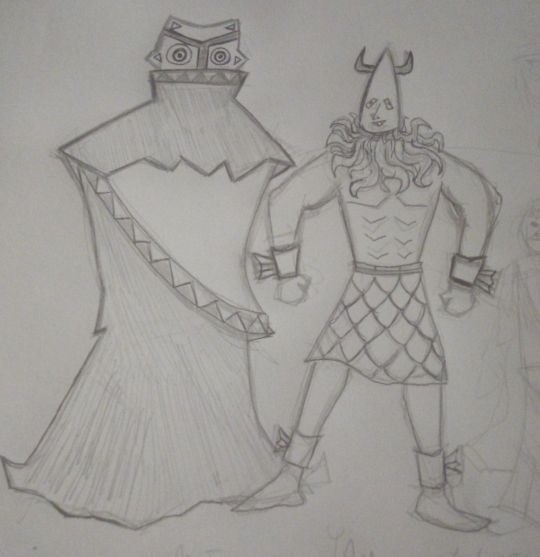
In the Rider of Clouds story itself? Exactly what it says on the tin - Yam and then Mot. Also Yam's nameless sidekick from the real myth sort of, but you'll have to wait to see how that works.
The setting is bigger than that, though, so more info under the cut.

I wanted to put a unique spin on Yam's origin and reference Ugarit's cultural milieu by equating him with his Hurrian analog Hedammu, so obviously it only makes sense to eventually use Hedammu's dad, Kumarbi, as an antagonist too. In the Rider of Clouds universe El and Athirat/Asherah were essentially put in power by Kumarbi as vassals (there's a theory that one of the minor antagonists from the Kumarbi cycle, Eltara, is a reflection of El; and I thought it would be funny to connect Athirat to Kumarbi's second in command and father in law, the sea, due to her sea-themed epithet) and are in a sort of awkward position in the present due to Kumarbi losing ground to Teshub, as described in the Kumarbi cycle.
Another reason for using Kumarbi is that he was kind of like a less friendly (at least in myths, let’s put cult aside) mirror of Dagan who I decided to make Baal’s father for real and not only via syncretism in the story. Since Dagan’s wife Shalash was associated with Kumarbi too, in Rider of Clouds she was actually initially his wife, but they split and she married Dagan instead.
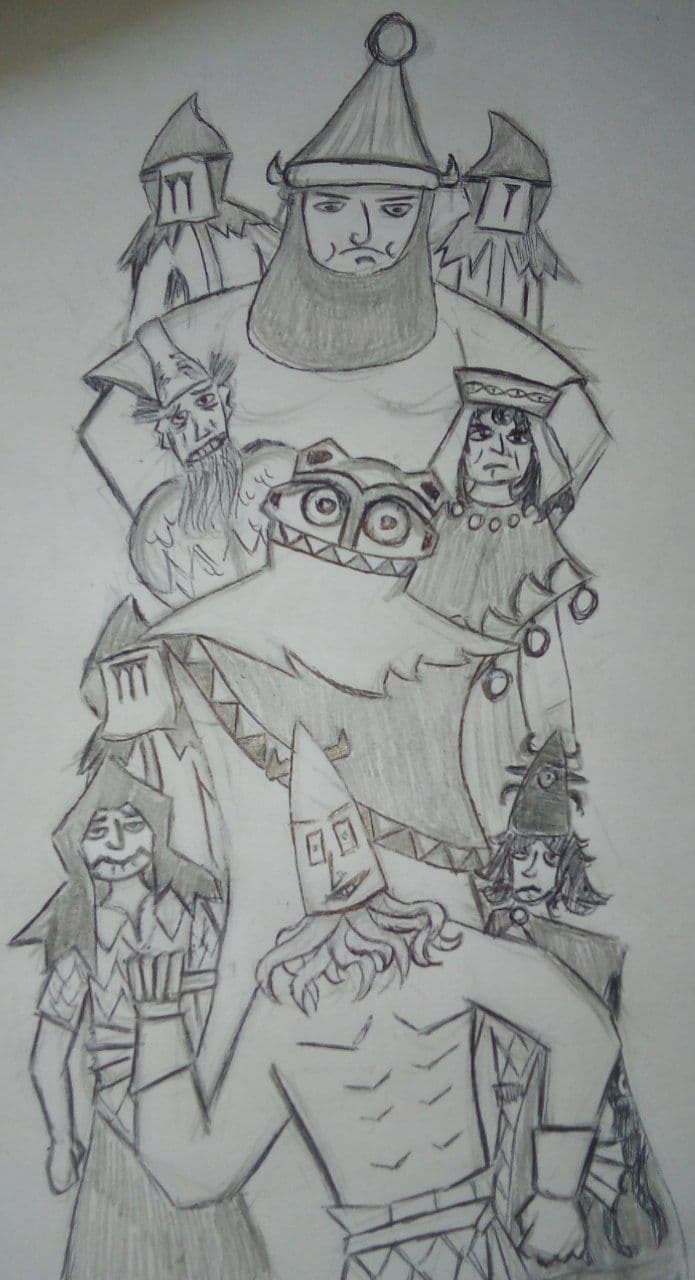
So, while not physically present in the Rider of Clouds story itself, Kumarbi is technically the main antagonist, I suppose, and Yam, Mot, El and Athirat are all connected to him to some degree (Mot not much, though). I'm considering having his servant deities appear as messengers inquiring first Yam, and then El and his wife, about the progress to set him up.
Character-wise I think the original myth provides a lot of material, as Kumarbi actually has a character arc, going from seeking to reclaim his kingship to essentially having no desire other than destroying the heroes, which makes him lose his mandate in the eyes of other deities depicted in it. Rider of Clouds takes place after the Hedammu myth, which is a turning points towards the latter in the narrative, so Kumarbi has relatively few allies left and is increasingly desperate at this point.

Which leads me to the next point - honestly the prime reason for using Kumarbi is the Ullikummi myth - it takes place near Mt. Saphon (known as Hazzi to the Hurrian authors of this cycle) so when I first read it all I could think of was "Wait, that's Baal's house," lol.
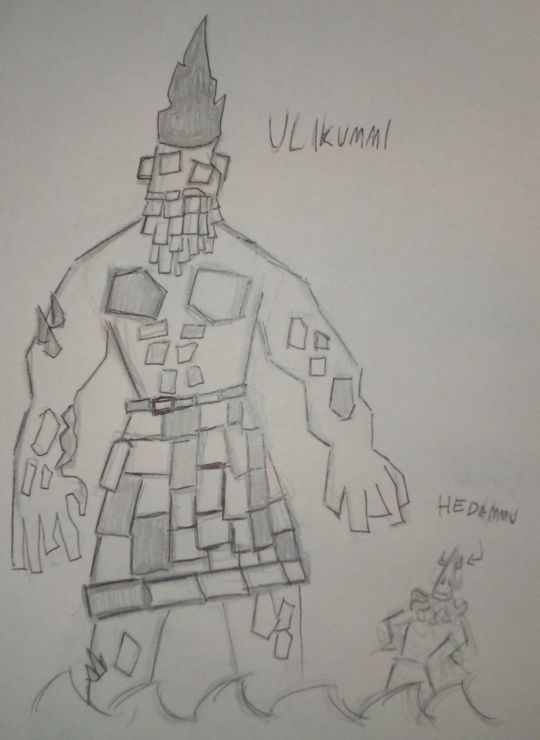
Ullikummi is, much like in the real myth, essentially a sentient mountain who constantly grows and lacks the issues of Kumarbi's previous proxies - he has no emotions and no needs and as such cannot be reasoned with or tricked, and won't accept a truce either.
While in the original myth Kumarbi comes up with this plan himself, there's one scene which puzzles me, namely that various side characters opt to inform Mesopotamian Enlil about Kumarbi's scheme which gave me the idea to insert Enlil's little known nemesis (and uncle) Enmesharra into the narrative as the consultant for Kumarbi's plan. Worth noting that in at least one text Kumarbi's largely irrelevant father Alalu is associated with Enmesharra, too, which I plan to at least allude to in Rider of Clouds.
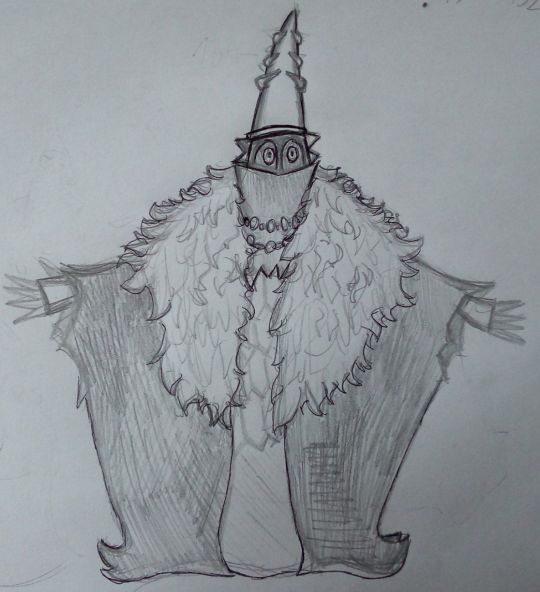
Enmesharra is, however, going to be the main villain of my Inanna story (Ninmesharra), not Rider of Clouds. I based his character on Frans Wiggermann's theory that he represented a revolt of the empty primordial cosmos against the gods and their attempts at making the universe orderly, which I want to extend into some ideological conflict about nihilism and assigning meaning to the world.
The Inanna story will have other antagonists too, but covering that would require another ask, I suppose.
17 notes
·
View notes
Quote
In the Cycle of Kumarbi (Hoffner 1998:40-2) the generation of Gods who are ruling under Their king, who is the Supreme God of the actual pantheon, is preceded by several earlier generations of heavenly kings; the succession of these kings was often violent; and the rule of the present Supreme God has to be defended against attackers: the Succession Myth narrates how the present order of things came into being and notes that this order did not go unchallenged. In the Hittite Song of Kumarbi, the primeval King Alalu is deposed by Anu (Sky), His vizier; Anu's son and vizier, Kumarbi, then deposes Anu. During the struggle with Anu, Kumarbi bites off Anu's testicles and swallows them, thus impregnating Himself; in a complex action that is only partially understood, He gives birth to Teshub (the Storm-God), Teshub's vizier Tasmisu, the Aranzah River, and several other Gods. From that moment on, the rivalry between the ruling Kumarbi and the pretender Teshub dominates the song cycle. Kumarbi seems to have tried to swallow Teshub again but was tricked into eating an object, perhaps a stone. Teshub might have become king already in the Song of Kumarbi, but in other narratives, Kumarbi challenges Him through several intermediaries, among them the monstrous sea serpent Hedammu (Song of Hedammu) and the stone giant Ullikummi, fathered by Kumarbi through intercourse with a rock.
“Myth” by Fritz Graf in Ancient Religions edited by Sarah Iles Johnston (p 49)
0 notes
Note
What aquatic mythical creature would you be?
Ruby: Cetus
Yang: Hedammu
Weiss: Mermaid or siren
Penny: Hafgufa
8 notes
·
View notes
Text
Porphyrion, whom Pindar links with Typhon in defeat beneath Zeus's thunderbolts and Apollo's arrows, was betrayed by his lust: Zeus put passion for Hera into him and he attacked her during battle (Th. 4E.), but Herakles rescued her, killing Porphyrion with his arrows while Zeus cast thunderbolts on him from above (Th. 7E). A similar story is told about Eurymedon, a king of Gigantes in the Odyssey, destroyed along with his people. According to Euphorion, he either actually succeeded in violating the girl Hera or she fell in love with him; after Zeus came to power he learned of this affair and cast Eurymedon into Tartaros. In these sources we can see the shadow of a story in which Hera deliberately lured the enemy to destruction: that is, Hera played the part of Paghat or Ishtar or Astarte, and Eurymedon that of Yatpan or Hedammu or Sea (pp. 139, 175, 191).33
Python: A Study of Delphic Myth and Its Origins
1 note
·
View note
Quote
Porphyrion, whom Pindar links with Typhon in defeat beneath Zeus’s thunderbolts and Apollo’s arrows, was betrayed by his lust: Zeus put passion for Hera into him and he attacked her during battle, but Herakles rescued her, killing Porphyrion with his arrows while Zeus cast thunderbolts on him from above. A similar story is told about Eurymedon, a king of Gigantes in the Odyssey, destroyed along with his people. According to Euphorion, he either actually succeeded in violating the girl Hera or she fell in love with him; after Zeus came to power he learned of this affair and cast Eurymedon into Tartaros. In these sources we can see the shadow of a story in which Hera deliberately lured the enemy to destruction: that is, Hera played the part of Paghat or Ishtar or Astarte and Eurymedon that of Yatpan or Hedammu or Sea.
Python. A Study of Delphic Myth and Its Origins by Joseph Fontenrose
4 notes
·
View notes
Note
For the character breakdown, I’d love to see hadad, anat, shapash, yam, mot, athtar, kothkar and khasis... really any of the ugaritic pantheon, of course you don’t have to do all of them >.<, I’d just love to see your hot takes
I shall rise up to the challenge! I’m the only person on this site obsessed with Ugarit as far as I can tell... I covered everyone you asked for plus Ashtart and Yarikh.
As much as I like burrowing through jstor and academia edu and persee and so on, I kind of wish there were more people approaching Ugaritic, Mesopotamian, Hittite etc. myths the way many do with Greek ones tbh - sometimes i’d just like to see which figures people think would be into gossiping and so on or which tacky modern fashion they think suits them equally as much as I want to find out if Yarikh’s portrayal in Ugaritic poetry owes more to Nanna/Sin or to the Hittite moon god.
ALSO as far as this sort of light hearted takes go, there are two japanese artists on twitter who draw Baal cycle fanart: here and here.
Hadad:
How I feel about this character: one of my fave mythical protagonist. I think I genuinely only like Inanna more. Going from a very relatable desire to get his own house to triumph over death is quite the journey. The relative powerlessness many interpreters point out is interesting, too - the fact he mostly gets somewhere because of allies and because even if El was the king of gods, Hadad’s attributes made him the king of people’s hearts arguably, so he has to win against overwheming odds.
All the people I ship romantically with this character: Anat, Ashtart/Astarte/however we transcribe her name this week... Kothar?
My non-romantic OTP for this character: given the Seth-Baal equation in Egypt and the uncertaininty over whether Astarte papyrus is about Seth or Baal under Seth’s name it’s funny to imagine them as friends. Also I’ll talk about it more underneath but since Dagan was a god with similar purposes further inland (and is attested earlier iirc) and Ugaritic texts - even though they rarely feature him - call him Hadad’s father - it would be cute to assume he also taught Hadad everything.
My unpopular opinion about this character: I’m a Dagan parentage truther against all odds. It was the norm outside Ugarit! I think “Dagan isn’t in Ugaritic myths because they take place in Ugarit but people thought Dagan lives further inland in Tuttul based on prayers etc.” is enough to explain his absence from myths, and also note that in the epic Baal is “Dagan’s son” even when he’s at a low point (ex. when Yam demands he gives up his freedom or when he’s dead) and only El’s and Asherah’s son when he’s victorious for the most part (ex. during palace construction) - imo this makes it plausible that Dagan is his real dad and El and Athirat are only his parents in the way vassal rulers called emperors fathers. Likewise I think any references to siblings can be interpreted in the light of ex. kings of Ugarit calling kings of Carchemish or Alashiya brothers.
One thing I wish would happen / had happened with this character in canon: I really like how corny the Hittite/Hurrian storm god cycle is with Kumarbi constaly raising new challengers to attack Kummiya and dethrone Teshub/Tarhunna, I actually wish the Ugaritic one was longer too via a similar plot device. Also I wish Dagan actually appeared in myths alongside his son - Noga Ayali-Darshan had a theory he was in some oral tradition predating Baal cycle as the god announcing Yam demands a tribute since in Hurrian “Song of the sea” and in Egyptian “Astarte papyrus” a grain deity does this but a possible reconstruction isn’t much...
Anat
How I feel about this character: well, she’s not Inanna, but she’s still pretty good. I mostly like the parts of the Baal narrative which show her unpredictable character, like her probable parents being afraid of her, listing various never shown enemies she vanquished, or Mot’s death. Aqhat myth doesn’t interest me much. That myth fragment where she and Ashtart pity Yarikh because other gods treat him poorly is interesting, too.
All the people I ship romantically with this character: Baal, Ashtart, that’s it I think.
My non-romantic OTP for this character: she seems to get along really well with Shapash during the segment of the Baal cycle where Baal is dead.
My unpopular opinion about this character: I really hate the speculation popular among bible scholars which amounts to making her, Ashtart and Athirat interchangeable to justify her irrelevance in the iron age.
One thing I wish would happen / had happened with this character in canon: honestly? I wish an “Anat cycle” existed. She pretty clearly had a fair share of own adventures considering Baal enlists her help on the account of past accomplishments.
Yam
How I feel about this character: out of all antagonists in the basic middle eastern “storm god vs sea” narratives I think he has the most fun personality - Hedammu is barely a “character” and Tiamat lacks the more human dimension Yam has.
All the people I ship romantically with this character: nobody, he has to move past the Astarte papyrus characterization and learn some respect for that smh
My non-romantic OTP for this character: his nameless rude messenger who refused to bow down when speaking to the assembly of the gods
My unpopular opinion about this character: contary to what this (very good) paper says, the Yam battle is more thrilling than the Mot one - the strength of the Mot part of the narrative comes from the visceral descriptions of Anat’s emotions but Mot is a flat villain compared to Yam.
One thing I wish would happen / had happened with this character in canon: he had a seemingly positive role in cult and there are 13 known people with Yam theophoric names (out of 6000 or so people from Ugarit known by name) so I sort of wonder if there’s some lost myth where he’s the hero or something.
Mot
How I feel about this character: if nothing else, feeling offended by being offered bread and wine instead of corpses is pretty funny and a great introduction. And the pathetic attempt at a comeback shut down by Shapash is
All the people I ship romantically with this character: unshippable by design tbh.
My non-romantic OTP for this character: if the theory about Horon - the god from the “anti-snakebite text” and the “may horon crack your skull” curse - being a cthtonic god too - just a generally benign one - is true I think they could have a lot of comedic potential.
My unpopular opinion about this character: I don’t understand where the idea of a nonexistent myth about Mot kidnapping Shapash and Yarikh comes from and I wish it wasn’t all over the place online.
One thing I wish would happen / had happened with this character in canon: some more detailed description of the afterlife - Mot, rephaim, Horon if he really lives there - would be useful...
Shapash
How I feel about this character: she seems severly... underrated? There are maybe two papers about her (and one underlines the fact there isn’t much research on her) and yet she’s the second most prominent goddess in the Baal cycle AND has her own narrative in the anti-snakebite texts! She might actually be more remarkable than her Mesopotamian counterpart - with all due respect for Utu/Shamash, in myths he’s the boring sibling between himself and Inanna/Ishtar...
All the people I ship romantically with this character: I don’t have any real ideas, some papers assume she and Horon were a thing but this is disputable and Horon is pretty nebulous himself...
My non-romantic OTP for this character: “Kothar - your close friend!” from that one hymn has that covered. Since she’s basically a divine herald perhaps they travel together?
My unpopular opinion about this character: I suspect the reason why she isn’t studied more is because many researchers are stuck with some sort of false “good mother goddess - evil sex goddess” dichotomy of ancient middle eastern religion and while you can force Athirat, Anat and Ashtart into these roles, Shapash with her aura of a divine equivalent of a mundane earthly official doesn’t fit into it and as such is ignored.
One thing I wish would happen / had happened with this character in canon: I said I hate the false Mot myth spreading online but I actually do wish there was a myth or at least a cult text of some sort showing what sort of relation existed between her and Yarikh - safe to say it didn’t mirror Shamash and Sin...
Kothar-wa-Khasis
How I feel about this character: huge fan of artisan gods and he seems genuinely nice. One of my Ugaritic b-list favorites. I like that he’s a reneissance man - armorer, architect, even a musician... The theory that he was developed based on Ptah since Memphis had a large foreign population is great.
All the people I ship romantically with this character: Baal sort of? I imagine Baal is actually relatively knowledgeable about architecture given the length of the window debate in the Baal cycle...
My non-romantic OTP for this character: Shapash, as I said earlier.
My unpopular opinion about this character: based on the tale of King Keret some researchers argue he’s meant to be ugly like Greek Haephestus, but since I like the Ptah theory and his appearance isn’t described elsewhere AND King Keret might be satire where everyone is their worst self possible, I prefer to imagine him as handsome
One thing I wish would happen / had happened with this character in canon: supposedly from Caphtor and yet we never see Caphtor (Crete) in Ugaritic myths... come on, ancient scribes, surely someone went there? Maybe even recorded some proper Minoan myths?
Ashtart
How I feel about this character: she’s my favorite Ugaritic figure of limited relevance. An Ishtar/Inanna equivalent who seemingly curses other gods and presides over political pacts is a pretty solid premise! And it’s funny she rebukes Baal seemingly for insufficient dedication in battle. I wonder if the Egyptian fragment which implies Yam acted lecherous towards her is a factor in this tbh. Perhaps an earlier oral tradition had both these elements...?
All the people I ship romantically with this character: Baal (her title is “face of baal”/”of the name of baal”, c’mon...), Anat (almost always listed together!)
My non-romantic OTP for this character: Keret curses his son with a formula invoking both Horon and her so perhaps that’s who she’s learning curses from.
My unpopular opinion about this character: I hate that “Astarte is Asherah” is widespread just because people want to defend the historicity of the biblical Jezebel narrative which probably even the biblical compilersdidn’t view as historical.
One thing I wish would happen / had happened with this character in canon: I wish she didn’t vanish from the Baal cycle after Yam’s defeat :C
Attar
How I feel about this character: this sure is... a guy. He’s so pathetic in the Baal cycle it’s hard to even see him as an antagonist - sorry, Handbook of Ugaritic Studies...
All the people I ship romantically with this character: nobody, Shapash points out he’s single as the reason why he can’t rule and i don’t think that changes in any subsequent texts? But then Marriage of Nikkal and Yarikh iirc mentions he has a daughter...
My non-romantic OTP for this character: again, nobody.
My unpopular opinion about this character: he’s actually a pretty vital part of the Baal cycle and the fact he gives up on own accord makes him more interesting than the other “failed god” in a similar narrative, Ashtabi.
One thing I wish would happen / had happened with this character in canon: a god with the same name was prominent in present day Yemen so I guess finding some direct connection would be nice - it fits with him leaving to “rule elsewhere” in the myth!
Yarikh
How I feel about this character: he’s so pitiful in the fragment which compares him to a dog begging for scraps... His main myth is pretty good too, tbh it’s the best middle eastern marriage myth imo - I actually don’t care for Dumuzi much, but Yarikh is cool.
All the people I ship romantically with this character: only Nikkal-wa-Ib
My non-romantic OTP for this character: given his mistreatment and Nikkal’s father(?) saying he could be a son in law of Baal I assume that in some unknown texts they must have been allies. Note that the Hittite storm god has the sun and moon gods acting as his metaphorical eyes warning him against Kumarbi’s new plots in song of Ullikummi. Also I assume Anat and Ashtart must consider him a friend given how they help him when nobody else does? All around he feels like a god in Baal’s orbit even though we have 0 direct proof for it.
My unpopular opinion about this character: I think trying to correct him to Nanna is a doomed endeavor tbh. Their wives have similar names but Yarikh doesn’t give the impression of a “Father of gods” type deity in what little we know about him.
One thing I wish would happen / had happened with this character in canon: more myths. None we know show him as the moon even though it’s literally his name!
I am afraid I don’t have anything interesting to say about El and Athirat. Handbook of Ugaritic Studies has an amazing El summary that I generally stick to, I can post a cap if you are interested.
19 notes
·
View notes
Text
After looking through more Mesopotamia-related articles, I urge you not to ue ancient.eu at all for research on its antiquity
The author of most articles relevant to Mesopotamia there has no background in history and every single article has some unfounded speculation which makes no sense.
Marduk didn’t replace Ishtar as Babylon’s tutelary god, he was there all along; Inanna/Ishtar did not influence the character of Tiamat in the Enuma Elish; Hittite Shaushka is compared to Amaterasu(sic) but Tiamat narrative isn’t compared to Yam, Hedammu and Illuyanka; Graves and his ilk are usually quoted instead of credible scholars - in the era where the credible scholarship is available free of charge on academia-edu, jstor and many other sites!
“World’s most popular ancient history encyclopedia” lmao.
10 notes
·
View notes
Text
Some stuff about meddling with genuine genealogy of ugaritic, hittite and mesopotamian gods in Rider of Clouds under the cut (feat. rough head sketches of Yam’s mom and grandpa)
one of the core ideas behind Rider of Clouds - and the wider “storm god (and inanna clone) vs the sea expanded cinematic universe” it evolved into - was to form some sort of coherent family tree which avoids the mythical staple of n-dimensional incest without making up too much and here’s what i have so far:
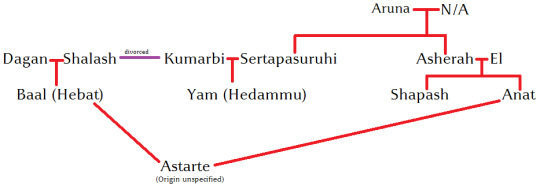
Dagan usually was said to have two children, Hadad (Baal) and Hebat, but as Hebat was replaced in her most prominent role irl by the sun goddess of Arinna during an effort to streamline the hittite pantheon, i figured it’d be funny to justify my take on Baal being a woman by making her both Hadad and Hebat - ie. a thunder deity named Hebat who wants to become the head god of Ugarit and is Dagan’s and Shalash’s daughter. She uses a male title because it was inherited from her father - happened a few times with various royals irl so w/e i think it’s fine enough for my f/f fantasy story based on bronze age epics.
In real myths Baal’s relationships are not entirely clear; since i’m not exactly into royal polygamy - and it’s not even clear if that’s actually the case in the myth - in my version Baal, Astarte, and Anat all eventually end up in love with each other, but with Astarte, not Baal, as the center of this subplot.
I cannot find any clear statement regarding Astarte’s parentage in Ugaritic mythology so in my version she’s a goddess from nowhere with no dynastic past to build clout off of. Her two ideas are imitating a more popular goddess from further east (Inanna) and living up to her irl title, Face of Baal, by guiding the latter’s career.
Even in the real myth I see Dagan as Baal’s real father, not El (ugaritic writers believed Dagan lives in Tuttul so no wonder he makes no physical appearance!) so of course this was carried over to my version. Dagan’s wife was sometimes also associated with Kumarbi, the opponent of the hittite storm god - so in my version they are divorced and both remarried.
I have a full backstory in mind for Dagan but I’m not yet ready to post it.

Since Yam and Hedammu are analogous, being possibly snake-like sea serpents fighting against a storm god who fights to claim the throne, aided by an inanna analog, in my version they are the same being (even though Baal and Teshub, and Astarte/Anat and Shaushka are not) - Hedammu is his given name, “prince Yam, judge Nahar” is his title, and the reason why he hates Baal at first sight already - like in the real myth - is due to already suffering a humiliating defeat at the hands of a similar god before.
I made Asherah a part of this family - otherwise entirely based on the villains from the Song of Hedammu - due to her sea-related titles and to keep some sort of blood relation between her and Yam even though he’s not her son in my story. As you can see Yam’s family is mostly hurrian/hittite, and i even designed Asherah based on Hittite queens. It all works ok, Ugarit was a Hittite vassal.
According to the real Song of Hedammu, Hedammu’s mother was “sweet like fresh cream” so while she keeps the sea invertebrate traits of her father and son, she’s meant to be less gruesome and is probably a reasonably nice person. Asherah looks human because she took after her mother, whoever it wouldn’t be (hittite texts mention aruna’s daughters but not a wife)
7 notes
·
View notes